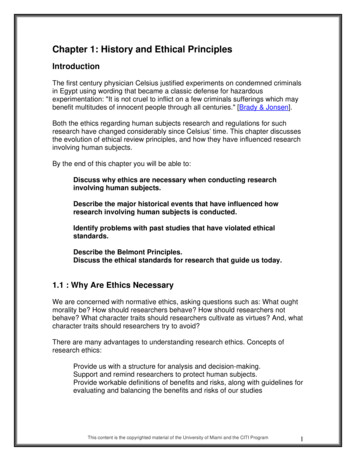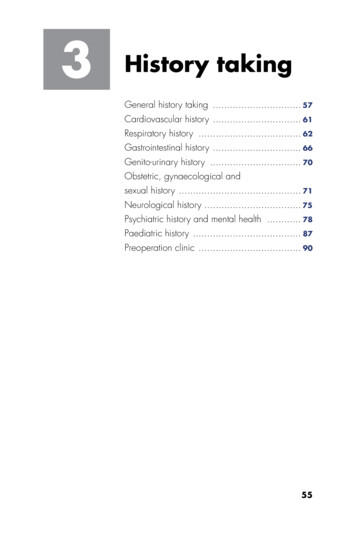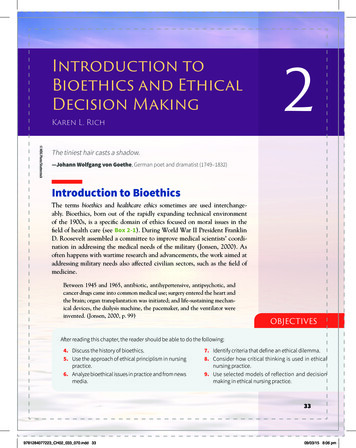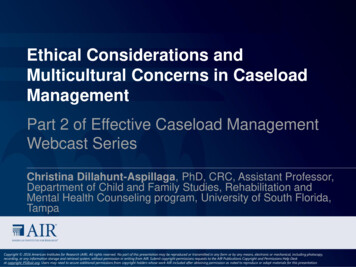
Transcription
Chapter 1: History and Ethical PrinciplesIntroductionThe first century physician Celsius justified experiments on condemned criminalsin Egypt using wording that became a classic defense for hazardousexperimentation: "It is not cruel to inflict on a few criminals sufferings which maybenefit multitudes of innocent people through all centuries." [Brady & Jonsen].Both the ethics regarding human subjects research and regulations for suchresearch have changed considerably since Celsius’ time. This chapter discussesthe evolution of ethical review principles, and how they have influenced researchinvolving human subjects.By the end of this chapter you will be able to:Discuss why ethics are necessary when conducting researchinvolving human subjects.Describe the major historical events that have influenced howresearch involving human subjects is conducted.Identify problems with past studies that have violated ethicalstandards.Describe the Belmont Principles.Discuss the ethical standards for research that guide us today.1.1 : Why Are Ethics NecessaryWe are concerned with normative ethics, asking questions such as: What oughtmorality be? How should researchers behave? How should researchers notbehave? What character traits should researchers cultivate as virtues? And, whatcharacter traits should researchers try to avoid?There are many advantages to understanding research ethics. Concepts ofresearch ethics:Provide us with a structure for analysis and decision-making.Support and remind researchers to protect human subjects.Provide workable definitions of benefits and risks, along with guidelines forevaluating and balancing the benefits and risks of our studiesThis content is the copyrighted material of the University of Miami and the CITI Program1
1.1.1: Definition of "Benefit"A benefit is the positive value or advantage of being part of the research study.This value or advantage might be concrete for individual subjects, like a greaterchance of having a good therapeutic outcome. Alternatively, it might be moreintangible and general. For example, the results from a study could be crucial tounderstanding the underlying socioeconomic causes of drug addiction.1.1.2: Definition of "Risk"Risks generally are evaluated according to the probability and magnitude of anyharm that might occur. Will the risk occur in almost all subjects or in only one of10,000 subjects? We can also quantify risk according to the magnitude of harm.Will the harm consist of some minor itchiness, or will some subjects die? Riskscan also be classified according to their type. In medical research we often focuson physical risk. However, risks may also be social, legal, economic orpsychological in nature. In addition, risks may apply to the individual subject ormay apply to a broader segment of the society.1.1.3: Balancing Benefits and RisksRisks to the subject or society must be weighed against potential benefits. Theprobability of harm relative to the probability of benefit should be determined, aswell as the relative magnitude of risks and possible benefits. As an aside,payment for study participation should never be considered a benefit. One of themost difficult things that researchers and IRBs have to do is to determine that thepotential benefits of the outcomes of the research outweigh the risks ofconducting the research. This is difficult because:Neither the potential benefits or risks can be known ahead of time.The risks are assumed by individuals, while the benefits may accrue tosociety at large rather than to individuals.1.2 : Historical Events that Have Influenced Human Research1.2.1: First Documented Human Subject ResearchThe development of research ethics has evolved over time. Among the firsthuman subject research experiments to be documented were vaccination trials inthe 1700's. In these early trials physicians used themselves or their familymembers as test subjects. For example:Edward Jenner (1749-1823) first tested smallpox vaccines on his son andon neighborhood children.This content is the copyrighted material of the University of Miami and the CITI Program2
Johann Jorg (1779-1856) swallowed 17 drugs in various doses to recordtheir properties.Louis Pasteur (1822-1895) "agonized over treating humans," even thoughhe was confident of the results obtained through animal trials. He finallydid so only when he was convinced the death of the child, the first testsubject, "appeared inevitable." [Rothman]1.2.2: The Era of Modern ScienceThe era of modern science started in the 1900's and the progress of medicinebegan to accelerate. Walter Reed's well-known experiments to develop aninoculation for yellow fever were at the forefront of these advances. Theseexperiments, however, unlike earlier experiments with vaccinations, werecarefully scrutinized.Dialog from testimony before the Royal Commission of Vivisection (1908)follows[Brady & Jonsen]:Commission: I understand that in the case of yellow fever the recentexperiments have been on man.Osler: Yes, definitely with the specific consent of these individuals who wentinto the camp voluntarily.Commission: We were told by a witness yesterday that, in his opinion, toexperiment upon man with possible ill result was immoral. Would that be yourview?Osler: It is always immoral, without a definite, specific statement from theindividual himself, with a full knowledge of the circumstances. Under thesecircumstances, any man, I think is at liberty to submit himself to experiments.Commission: Given voluntary consent, you think that entirely changes thequestion of morality or otherwise?Osler: Entirely.1.2.3: Nuremberg CodeSociety's high regard for the medical profession, however, was not to last. At theend of World War II, 23 Nazi doctors and scientists were put on trial for themurder of concentration camp inmates who were used as research subjects. Ofthe 23 professionals tried at Nuremberg, 15 were convicted, 7 were condemnedto death by hanging, 8 received prison sentences from 10 years to life, and 8This content is the copyrighted material of the University of Miami and the CITI Program3
were acquitted. [Mitscherlich & Mielke] Included in the legal judgment andsentences handed down at the culmination of the trial were ten points describingrequired elements for conducting research with humans. These points becameknown as the Nuremberg Code.In summary, the Nuremberg Code includes the following guidance forresearchers:Informed consent is essential.Research should be based on prior animal work.The risks should be justified by the anticipated benefits.Only qualified scientists must conduct research.Physical and mental suffering must be avoided.Research in which death or disabling injury is expected should not beconducted.1.2.4: Effect of the Nuremberg CodeThe Code had little impact on researchers in the United States, who thought thatthe principles in the Code were already implicit in their work and that it wassimply a document to condemn the Nazi atrocities and to convict the Nazidoctors. There were a number of problems with the Code itself. For example itdid not have the strength of law, it was created post hoc, and it applied to onlynon-therapeutic human subjects research.1.2.5: Declaration of HelsinkiIn 1964 the World Medical Association developed a code of research ethics thatcame to be known as the Declaration of Helsinki. It was a reinterpretation of theNuremberg Code, with an eye to medical research with therapeutic intent.Subsequently, journal editors required that research be performed in accordancewith the Declaration. In principle, this document set the stage for theimplementation of the Institutional Review Board (IRB) process. [Shamoo &Irving]1.2.6: Beecher ArticleIn 1966 Dr. Henry K. Beecher, an anesthesiologist, wrote an article (Beecher HK."Ethics and Clinical Research" NEJM June 16, 1966) describing 22 examples ofresearch studies with controversial ethics that had been conducted by reputableresearchers and published in major journals. Beecher wrote, "medicine is sound,and most progress is soundly attained;" however, if unethical research is notprohibited it will "do great harm to medicine." Beecher provides estimates of thenumber of unethical studies and concludes, "unethical or questionably ethicalprocedures are not uncommon." [Beecher]This content is the copyrighted material of the University of Miami and the CITI Program4
Beecher's article played an important role in heightening the awareness ofresearchers, the public, and the press to the problem of unethical humansubjects research. "Until this article we assumed that unethical researchcould only occur in a depraved regime like the Nazis."- Robert J. Levine, MD(personal communication).1.3 : Ethical Problems with Past Studies1.3.1: Ethical ProblemsThe Beecher article and increased public awareness brought to light problemswith ethics in research such as the following:1. Lack of informed consent2. Coercion or undue pressure on volunteers (or on a parent to volunteertheir child)3. Use of a vulnerable population4. Exploitation of a vulnerable population5. Withholding information6. Withholding available treatment7. Withholding information about risks8. Putting subjects at risk9. Risks to subjects outweigh benefits10. Deception11. Violation of rights1.3.2: Historic Case StudiesEach of the following exhibited one or more of the ethical problems listed above.1.3.2.1: Willowbrook Hepatitis StudyIn 1956, at an institution for mentally retarded children in Staten Island, NewYork, a study was initiated to determine the natural history of viral hepatitisand to test the effectiveness of gamma globulin as an agent for inoculatingagainst hepatitis. Children were deliberately infected with a mild form ofhepatitis.The investigators defended the study by stating that most new children wouldbecome infected with hepatitis within their first 6-12 months at the institution.Although permission was obtained from parents, the parents were not fullyinformed of the possible hazards involved in the study. There is evidence thatthe parents were led to believe that the child would not be enrolled at theschool unless the parents signed the consent form.This content is the copyrighted material of the University of Miami and the CITI Program5
Ethical problems: exploitation of a vulnerable group of subjects, withholdinginformation about risks, coercion or undue pressure on parents to volunteertheir children. [Munson]1.3.2.2: Jewish Chronic Disease StudyIn 1963 live cancer cells were injected into senile patients without theirknowledge as part of a study of immunity to cancer. Since the investigatorsbelieved that the cells would be rejected, the researchers did not inform thepatients or seek consent because they did not want to frighten them.Ethical problems: lack of informed consent, use of a vulnerable group ofsubjects. [Levine]1.3.2.3: San Antonio Contraception StudyIn San Antonio, Texas, a number of Mexican-American women participated ina 1971 study to determine side effects of an oral contraceptive. The womencame to a clinic seeking contraceptives. Unbeknownst to them, the study wasdesigned so that half the women would receive oral contraceptives for the firsthalf of the study, then switched to placebo. The women initially receivingplacebo were placed on the oral contraceptive for the second half of thestudy. 10 of the 76 subjects became pregnant while using placebo.Ethical problems: lack of informed consent, use of a vulnerable group ofsubjects, risks to subjects outweighed benefits. [Levine]1.3.2.4: Tea Room Trade StudyThe study planned first to obtain information about homosexual practices inpublic restrooms and then to conduct further investigation on the men whotook part in the acts. The researcher went undercover and gained theconfidence of the men by acting as a "look out." The researcher identified 100active subjects by tracing their car license numbers. A year after hecompleted the initial study of direct observation of homosexual acts theresearcher distributed a "social health survey" throughout the communitieswhere he knew the subjects lived.Ethical problems: use of a vulnerable population, reinforced image that socialscientists use deception casually in research, lack of informed consent.[Warwick]1.3.2.5: Obedience to Authority Study (Milgram Study)The purpose of this study was to determine response to authority in normalhumans. The researchers told recruited volunteers that the purpose was tostudy learning and memory. Each subject was told to teach a "student" and toThis content is the copyrighted material of the University of Miami and the CITI Program6
punish the students' errors by administering increasing levels of electricshocks. The "student" was a confederate of the researcher who pretended tobe a poor learner and mimicked pain and even unconsciousness as thesubject increased the levels of electric shock. 63% of the subjectsadministered lethal shocks; some even after the "student" claimed to haveheart disease. Some of the subjects, after being "debriefed" from the studyexperienced serious emotional crises.Ethical Problems: deception, unanticipated psychological harms.1.3.2.6: The Public Health Service Syphilis Study (1932-1971)Initiated by the Public Health Service, this study was designed to documentthe natural history of syphilis in African-American men.At the time the study began there was no known treatment for syphilis.Hundreds of men with syphilis and hundreds of men without syphilis (servingas controls) were enrolled into the study. The men were recruited without trulyinformed consent. They were deliberately misinformed about the need forsome of the procedures. For example, spinal taps were described asnecessary and special "free treatment."Even after penicillin was found to be a safe and effective treatment for syphilisin the 1940's, the men were denied antibiotics. The study continued to trackthese men until 1972 when the first public accounts of the study appeared inthe national press. The study resulted in 28 deaths, 100 cases of disability,and 19 cases of congenital syphilis. [Levine]Ethical problems: lack of informed consent, deception, withholdinginformation, withholding available treatment, putting men and their families atrisk, exploitation of a vulnerable group of subjects who would not benefit fromparticipation.1.4 : The Belmont Principles1.4.1: Research Ethics since the 1970sThe Public Health Service (PHS)Syphilis Study is among the most influential inshaping public perceptions of research involving human subjects. After the press"blew the whistle" on the PHS Syphilis Study, Congress formed an Ad HocPanel. The Panel determined that the PHS Syphilis Study should be stoppedimmediately and that oversight of human research was inadequate. The Panelrecommended that federal regulations be designed and implemented to protecthuman research subjects in the future. Subsequently, federal regulations wereenacted including the National Research Act, 45 Code of Federal Regulations46, and 21 Code of Federal Regulations 50.This content is the copyrighted material of the University of Miami and the CITI Program7
1.4.2: The National CommissionIn 1974 Congress authorized the formation of the National Commission for theProtection of Human Subjects in Biomedical and Behavioral Research, known tomost people in research ethics as The National Commission. Congress chargedthe National Commission to identify the basic ethical principles that underlie theconduct of human research--to look at the writings and discussion that had takenplace up to this time and to ask, "What are the basic ethical principles that peopleare using to judge the ethics of human subject research?"Congress also asked the National Commission to develop guidelines to assurethat human research is conducted in accordance with those principles.1.4.3: The Belmont ReportThe National Commission met and in 1979 published the Belmont Report. TheBelmont Report is "required reading" for everyone involved in human subjectresearch.The Belmont Report identifies three basic ethical principles that underlie allhuman subject research. These principles are commonly called the BelmontPrinciples. The Belmont Principles are respect for persons, beneficence, andjustice.1.4.4: The Belmont Principles1.4.4.1: Respect for PersonsThis principle is found in the writings of philosopher Immanuel Kant. Itrequires us to treat individuals as autonomous human beings and not to usepeople as a means to an end. We must allow people to choose forthemselves and provide extra protection to those with limited autonomy.Elements of autonomy include:Mental capacity, the ability to understand and process information.Voluntariness, freedom from the control or influence of others.Therefore, subjects have full autonomy when they have the capacity tounderstand and process information, and the freedom to volunteer forresearch without coercion or undue influence from others.Rules derived from the principle of respect for persons include:The requirement to obtain informed consent.The requirement to respect the privacy of research subjects.This content is the copyrighted material of the University of Miami and the CITI Program8
1.4.4.2: BeneficenceThis principle reminds us to minimize harms and maximize benefits. Derivedrules include:The requirement to use the best possible research design tomaximize benefits and minimize harms.The requirements to make sure the researchers are able to performthe procedures and handle the risks.The prohibition of research that is without a favorable risk-benefitratio.1.4.4.3: JusticeThe principle of justice requires us to treat people fairly and to designresearch so that its burdens and benefits are shared equitably. Derived rulesinclude:The requirement to select subjects equitably.The requirement to avoid exploitation of vulnerable populations orpopulations of convenience.1.4.5: Balancing the Three PrinciplesIt was the Commission's intention that each of the three principles should haveequal moral force. This means that in some situations, the three principles mightbe in conflict with one another. For example, we might derive from the principle ofrespect for persons that we should limit the involvement of children in researchbecause children are unable to choose for themselves. But, we might derive fromthe principle of justice that we must involve children in studies so that children willhave the opportunity to benefit from the research. The Belmont Report says thatone principle does not always outweigh another. Rather, we are required toconsider each case separately and on its own merits in light of all threeprinciples.1.5 : Ethical Standards for Research that Guide Us TodayIn the last several years reports of unethical studies including gene transfer,cancer, and psychiatric research have heightened the public awareness of theseissues even further. Two recent examples follow:-Death of a Normal VolunteerOn March 31, 1996, a 19-year-old Asian American student at the University ofRochester responded to an advertisement for study subjects to undergobronchoscopy for the harvest of alveolar macrophages. The bronchoscopy wasdifficult and required numerous doses of topical lidocaine. The investigatorsThis content is the copyrighted material of the University of Miami and the CITI Program9
repeatedly asked the subject if she wanted to continue and the subject noddedher head "yes". The study was completed, but the subject returned to the hospitalin cardiac arrest from an overdose of lidocaine and died April 2, 1996. Aninvestigation into this death revealed that the protocol did not limit lidocainedoses, that the doses were not documented, that the subject was not observedafter the bronchoscopy, and that the concentrations of lidocaine were increasedwithout IRB approval.-Death on Gene Therapy TrialIn the fall of 1999, eighteen-year-old Jesse Gelsinger died as a result of hisparticipation
1.3.2.1: Willowbrook Hepatitis Study In 1956, at an institution for mentally retarded children in Staten Island, New York, a study was initiated to determine the natural history of viral hepatitis and to test the effectiveness of gamma globulin as an agent for inoculating against hepatitis











